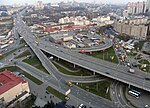Battle of Kiev (1943)

The Second Battle of Kiev was a part of a much wider Soviet offensive in Ukraine known as the Battle of the Dnieper involving three strategic operations by the Soviet Red Army and one operational counterattack by the Wehrmacht, which took place between 3 November and 22 December 1943. Following the Battle of Kursk, the Red Army launched the Belgorod-Kharkov Offensive Operation, pushing Erich von Manstein's Army Group South back towards the Dnieper River. Stavka, the Soviet high command, ordered the Central Front and the Voronezh Front to force crossings of the Dnieper. When this was unsuccessful in October, the effort was handed over to the 1st Ukrainian Front, with some support from the 2nd Ukrainian Front. The 1st Ukrainian Front, commanded by Nikolai Vatutin, was able to secure bridgeheads north and south of Kiev.
Excerpt from the Wikipedia article Battle of Kiev (1943) (License: CC BY-SA 3.0, Authors, Images).Battle of Kiev (1943)
Stratehichne Road, Kyiv Demiivka
Geographical coordinates (GPS) Address Nearby Places Show on map
Geographical coordinates (GPS)
| Latitude | Longitude |
|---|---|
| N 50.4 ° | E 30.54 ° |
Address
Stratehichne Road 48/52
03028 Kyiv, Demiivka
Ukraine
Open on Google Maps








